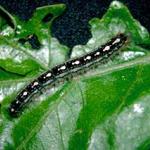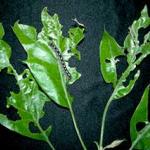Forest Tent Caterpillar
Order: Lepidoptera
Family: Lasiocampidae
Malacosoma disstria
Overview
The forest tent caterpillar is native to Massachusetts and North America. Unlike its common name suggests, it does not build a tent. The forest tent caterpillar will feed on the leaves of many host plants, including but not limited to: oak, poplar, aspen, willow, elm and many others. Mature forest tent caterpillars are present at the end of spring, or in the early summer. This is the same time at which the mature caterpillars of the eastern tent caterpillar and the spongy moth are present. The three may be found together and are sometimes confused. However, the forest tent caterpillar can be distinguished by the oval white spots down the back of the caterpillar that are sometimes described as "key holes" or "tiny penguins". The eastern tent caterpillar has a long, white line in place of these white oval spots, and the spongy moth caterpillar has five pairs of blue followed by six pairs of red raised bumps or dots in this location. Forest tent caterpillar populations are kept naturally low by an abundance of natural enemies. As such, they typically do not require chemical management interventions. However, the population does occasionally reach outbreak levels, which subsequently will crash.
Host Plants
Several different deciduous hosts of the forest tent caterpillar include but are not limited to: ash (Fraxinus spp.), basswood (Tilia spp.), birch (Betula spp.), blackgum (Nyssa sylvatica), elm (Ulmus spp.), hawthorn (Crataegus spp.), maple (Acer spp.), oak (Quercus spp.), poplar (Aspen spp.), sugar maple (Acer saccharum), sweetgum (Liquidambar spp.), and willow (Salix spp.). Host plant preference of the forest tent caterpillar may vary by geographic location. In the western United States, aspen is the preferred host. If trees are defoliated, atypical hosts such as understory shrubs and the leaves of fruit and vegetable plantings may be fed upon by hungry, wandering larvae.
Identification/Life Cycle
The egg masses (1/2 to 1.5 inches long) of the forest tent caterpillar overwinter and are similar to those of the eastern tent caterpillar (Malacosoma americanum) in the sense that they are wrapped around host plant twigs and coated in a shiny substance (spumaline). The main difference is that the ends of the forest tent caterpillar egg masses are square in shape, whereas the eastern tent caterpillar egg masses are tapered. Eggs hatch in the spring and the caterpillars migrate to the canopy of the tree, in search of expanding flower and leaf buds to feed on. Larvae continue to feed on the foliage of their host plants as it becomes available. They will feed together in groups when caterpillars are still small, but may wander individually as they mature. Caterpillars may reach up to 2 inches in length and are blue and gray with oval white spots down the back that are sometimes described as "key holes" or "tiny penguins". Pupation occurs after they spin pale yellow cocoons in folded leaves attached to plants or buildings. Adults are tan colored moths, approximately 1.6 inches long with two dark brown stripes on each forewing. Moths are active in the late afternoon and at night and are attracted to lights. One generation of forest tent caterpillars occurs per year.
Damage
The forest tent caterpillar can periodically be a significant defoliator of deciduous trees in its native range. However, population outbreaks typically soon collapse due to naturally occurring parasites, predators, and pathogens that regulate forest tent caterpillar populations. Depending upon the size of the population, partial to complete defoliation of hosts can occur. Young caterpillars may cause shothole-like damage to leaves prior to complete defoliation by the larger caterpillars. Small populations of forest tent caterpillars may be tolerated. While tree growth may be inhibited following a forest tent caterpillar outbreak, tree death is not usually observed. (Not without other contributing factors.) This is an early season defoliator.
Management Strategies:
The forest tent caterpillar does not make a large obvious web like the eastern tent caterpillar or fall webworm. Look for shotholes in deciduous plant leaves early in the spring. Large caterpillars tend to feed at night and hide near the ground during the day. Abundant natural enemies typically regulate populations of this insect, thus leading to minimal host plant damage. In years when a population outbreak does occur, chemical management options for the forest tent caterpillar are legally available in Massachusetts.
Cultural/Mechanical Management:
Mechanical management of forest tent caterpillar egg masses by pruning out or otherwise removing them from favored host trees prior to egg hatch in the spring is possible on smaller trees or shrubs where they can be seen and reached.
After egg hatch, forest tent caterpillar larvae can be handpicked and removed from ornamental trees and shrubs. Physical barriers (such as tree wraps) can be placed around tree trunks (coat the tree wrap, not the bark, with a sticky material) to capture wandering caterpillars during heavy population years. This may help capture some of the caterpillars moving on smaller trees, as long as the sticky barriers are removed and replaced frequently. (Caterpillars will crawl over a coating of dead caterpillars if they are stuck to the barrier.)
Biological Control/Natural Enemies:
There are many parasites, pathogens, and predators of the native forest tent caterpillar which are likely responsible for maintaining low populations of this insect, with the exception of the occasional outbreak year. There are several species of parasitic wasp, as well as the fly Sarcophaga aldrichi, which resembles a large house fly and is often noticeably abundant during outbreaks. Pathogens such as the caterpillar killing fungus, Entomophaga aulicae and a nucleopolyhedrosis virus (NPV virus) also regulate forest tent caterpillar populations.
Chemical Management:
Many active ingredients are labeled for use against forest tent caterpillars in Massachusetts, including but not limited to: abamectin (NL), acephate (NL), acetamiprid (L), azadirachtin (NL), Bacillus thuringiensis subsp. kurstaki (NL), Beauveria bassiana (NL), bifenthrin (NL), carbaryl (L), chlorantraniliprole (NL), Chromobacterium subtsugae (NL), cyantraniliprole (NL), cyfluthrin (NL), deltamethrin (L), emamectin benzoate (L), flonicamid+cyclaniliprole (N), gamma-cyhalothrin (L), horticultural oil (L), indoxacarb (L), insecticidal soap (NL) lambda-cyhalothrin (L), malathion (L), methoxyfenozide (NL), neem oil (NL), permethrin (L), pyrethrins+sulfur (NL), spinetoram+sulfoxaflor (N), spinosad (NL), tau-fluvalinate (NL), tebufenozide (NL) and zeta-cypermethrin (L). Contact a Massachusetts licensed pesticide applicator for assistance.
Read and follow all label instructions for safety and proper use. If this information contradicts language on the label, follow the most up-to-date instructions on the product label. Always confirm that the site you wish to treat and the pest you wish to manage are on the label before using any pesticide. Active ingredients labeled "L" indicate some products containing the active ingredient are labeled for landscape uses on trees or shrubs. Active ingredients labeled "N" indicate some products containing the active ingredient are labeled for use in nurseries. Always confirm allowable uses on product labels. This active ingredient list is based on what was registered for use in Massachusetts at the time of publication. This information changes rapidly and may not be up to date. If you are viewing this information from another state, check with your local Extension Service and State Pesticide Program for local uses and regulations.
See the Professional Insect & Mite Management Guide for Woody Plants for more information about forest tent caterpillar management on trees and shrubs.
References
Minnesota Department of Natural Resources: Forest Tent Caterpillar
NC State Extension: Forest Tent Caterpillar
University of Maine Cooperative Extension: Forest and Eastern Tent Caterpillars
University of New Hampshire: Forest Tent Caterpillar Defoliation in the North Country
US Forest Service: Forest Tent Caterpillar




